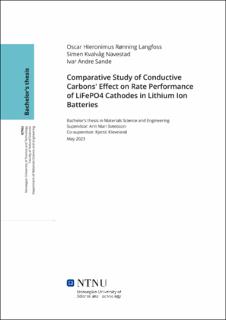| dc.contributor.advisor | Svensson, Ann Mari | |
| dc.contributor.advisor | Kleveland, Kjersti | |
| dc.contributor.advisor | Reite, Ragnhild Åkre | |
| dc.contributor.advisor | Amos, Charles Dallas | |
| dc.contributor.author | Langfoss, Oscar Hieronimus Rønning | |
| dc.contributor.author | Navestad, Simen Kvalvåg | |
| dc.contributor.author | Sande, Ivar Andre | |
| dc.date.accessioned | 2023-07-11T17:23:35Z | |
| dc.date.available | 2023-07-11T17:23:35Z | |
| dc.date.issued | 2023 | |
| dc.identifier | no.ntnu:inspera:146717571:150648168 | |
| dc.identifier.uri | https://hdl.handle.net/11250/3077916 | |
| dc.description.abstract | Målet med denne studien var å undersøke og sammenligne ulike ledende karbons effekt på ytelsen til LiFePO4 (LFP)-katoder i litium-ionbatterier. Metoder for å produsere LFP-katoder, sette sammen LFP-knappceller og syklisk testing ble laget og prøvd. De tre ledende karbonene som ble undersøkt var SUPER C45 (C45), Ketjenblack (KB) og SFG15L (SFG). De ble målt til å ha et BET-overflateareal på henholdsvis 45, 1332 og 9 m^2/g. Fra XRD-analyse viste C45 og KB seg å ha amorfe og svært amorfe mikrostrukturer, mens SFG hadde en svært krystallinsk profil.
En oppskrift for produksjon av katoder ble utviklet og brukt. Det var nødvendig med et faststoffinnhold på 40 % for C45 og SFG, og 30 % for KB for å gjøre slurryene egnet for "casting" og gjøre dem sammenlignbare. Dette ga opphav til "mass loading"-verdiene 6,3, 4,5 og 6,6 mg/cm^2 for henholdsvis C45, KB og SFG. En standard og reproduserbar måte å sette sammen knappceller ble funnet og brukt. En passende CCCV-syklusprotokoll for "rate performance" ble strukturert basert på den teoretiske kapasiteten for LFP og mass loading-en til hver prøve. Et strømbegrensende trinn på 30 % ble valgt i forhold til C-ratene for hver prøve.
Knappcellene ble "rate"-testet ved C-ratene; C/10, C/3, C/2, 1C, 2C og 5C. Til slutt ble et trinn med C/3 brukt som et "capacity retention"-trinn. KB-cellene oppnådde litt høyere utladningskapasitet ved alle ytelsestrinn, bortsett fra 2C, hvor C45-cellene ytet litt bedre enn KB-cellene. SFG-cellene oppnådde dårligere ytelsesresultater for alle C-rater, sammenlignet med de to andre. C45- og KB-cellene beholdt 85 % og 74 % av kapasiteten mellom de to ratene på C/3, mens SFG-cellene hadde ikke-anvendbare kapasitetsbevaringsresultater.
Analyse av ytelsesresultatene viste at de ledende karbonene C45 og KB er akseptable som tilsetningsstoffer i LFP-katoder. Dette ble spekulert i å skyldes deres amorfe struktur som ga opphav til forgrenede elektriske forbindelser og høy elektronisk ledningsevne. KB-cellene presterte dårligere i enkelte ytelsesmålinger. Dette ble antatt å være på grunn av KB-pulverets høye overflateareal som reduserte det indre porevolumet i katoden. Dette kan ha begrenset fordelingen av elektrolytt og dermed redusert den ioniske ledningsevnen. Det ble også funnet at SFG ikke er et passende ledende tilsetningstoff i LFP-katoder. Dette ble begrunnet i cellenes dårlige ytelse, noe som mulig kan forklares av pulverets svært krystallinske mikrostruktur og lave overflateareal. | |
| dc.description.abstract | The aim of this comparative study was to investigate and compare different conductive carbons' effect on rate performance of LiFePO4 (LFP) cathodes in lithium ion batteries. Methods for producing LFP cathodes, assembling LFP coin cells and cycling testing were made and tried. The three conductive carbon blacks investigated were SUPER C45 (C45), Ketjenblack (KB) and SFG15L (SFG). They were found to have BET surface areas of 45, 1332 and 9 m^2/g, respectively. From XRD analysis, C45 and KB exhibited amorphous and highly amorphous microstructures, while SFG displayed a highly crystalline profile.
A formulation for cathode production was found and used. A solid content of 40% for C45 and SFG, and 30% for KB was needed to make the slurries suitable for casting and made the cathode compositions comparable. These solid contents gave rise to mass loadings of 6.3, 4.5 and 6.6 mg/cm^2 for C45, KB and SFG, respectively. A standard and reproducible way of assembling coin cells was used. An appropriate CCCV cycling protocol for rate performance was structured based on the theoretical capacity of LFP and the mass loading of each sample. A current limiting step of 30% was set in relation to the C-rates of each sample.
The coin cells were rate tested at the C-rates; C/10, C/3, C/2, 1C, 2C and 5C. As a capacity retention step, a second C/3 step was used. The KB cells obtained slightly higher discharge capacities at all rate performance steps, except 2C, where the C45 cells slightly outperformed the KB cells. The SFG cells obtained comparably worse rate performance results for all C-rates. The C45 and KB cells retained 85% and 74% of their capacity through the two rates of C/3, while the SFG cells had non-applicable capacity retention results.
From analysis of the rate performance results, it was found that the conductive carbons C45 and KB made for acceptable additives in LFP cathodes. This was speculated to be due to their amorphous structure which gave rise to branching electrical pathways and great electronic conductivity. The KB cells performed worse in some rate performance metrics, and this was thought to be because of its high surface area which decreased the pore volumes within the cathode, which disturbed the electrolyte distribution and thereby decreased the ionic conductivity. SFG was found to not be a suitable conductive additive in LFP cathodes, due to its poor rate performance, fostered by its low surface area. | |
| dc.language | eng | |
| dc.publisher | NTNU | |
| dc.title | Comparative Study of Conductive Carbons' Effect on Rate Performance of LiFePO4 Cathodes in Lithium Ion Batteries | |
| dc.type | Bachelor thesis | |
